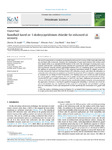Mostrar o rexistro simple do ítem
Nanofluid based on 1-dodecylpyridinium chloride for enhanced oil recovery
| dc.contributor.author | Al-Asadi, Akram | |
| dc.contributor.author | Somoza Cerviño, Alba | |
| dc.contributor.author | Arce, Alberto | |
| dc.contributor.author | Rodil, Eva | |
| dc.contributor.author | Soto, Ana | |
| dc.date.accessioned | 2023-04-26T08:01:21Z | |
| dc.date.available | 2023-04-26T08:01:21Z | |
| dc.date.issued | 2023-02 | |
| dc.identifier.citation | Al-Asadi A, Somoza A, Arce A, Rodil E, Soto A. Nanofluid based on 1-dodecylpyridinium chloride for enhanced oil recovery. Petroleum Science [Internet]. 2023 Feb [cited 2023 Apr 26];20(1):600–10. Available from: https://linkinghub.elsevier.com/retrieve/pii/S1995822622001972 | es_ES |
| dc.identifier.issn | 1995-8226 | |
| dc.identifier.uri | http://hdl.handle.net/2183/32940 | |
| dc.description.abstract | [Abstract] The use of nanoparticles is considered promising for enhanced oil recovery (EOR), especially when they are combined with surfactants. However, the combination of nano-sized material with surface-active ionic liquids (SAILs) is an unexplored EOR method. In this work, the advantages of mixing Al2O3 nanoparticles with the SAIL 1-dodecylpyridinium chloride were investigated. Stable nanofluids in brine could only be achieved using the polymer polyvinylpyrrolidone (PVP) as a stabilizing agent. It was found that the addition of nanoparticles (and PVP) to the surfactant formulation helped to: slightly increase its viscosity, enhance its water-oil interfacial tension (IFT) reduction capacity, and reduce the adsorption on carbonate rocks (adsorption on sandstone was found to be excessive). IFT was selected as target property to minimize for the design of EOR formulations. Core flooding tests were carried out with surfactant (0.5 wt% [C12py]Cl), surfactant-polymer (0.5 wt% [C12py]Cl, 1.0 wt% PVP) and nanofluid (0.05 wt% Al2O3, 1.0 wt% PVP, 0.5 wt% [C12py]Cl) formulations in brine (0.5 wt% NaCl). Additional oil recoveries of 3.4%, 7.4% and 12.0% OOIP were achieved, respectively, the nanofluid formulation being the most promising for the application. Moreover, it was found capable of changing the wettability of carbonate rocks from oil-wet to intermediate-wet. The significance of this work lies in showing the new possibilities resulting from the combination of SAILs and nanoparticles for EOR, specifically the combination of [C12py]Cl with Al2O3. | es_ES |
| dc.description.sponsorship | Ministerio de Ciencia e Innovación; PGC2018-097342-B-I00 | es_ES |
| dc.language.iso | eng | es_ES |
| dc.publisher | Elsevier | es_ES |
| dc.relation.uri | https://doi.org/10.1016/j.petsci.2022.08.018 | es_ES |
| dc.rights | Attribution-NonCommercial-NoDerivatives 4.0 International (CC BY-NC-ND 4.0) https://creativecommons.org/licenses/by-nc-nd/4.0/ | es_ES |
| dc.rights.uri | http://creativecommons.org/licenses/by-nc-nd/3.0/es/ | * |
| dc.subject | Nanofluid | es_ES |
| dc.subject | Viscosity | es_ES |
| dc.subject | Interfacial tension | es_ES |
| dc.subject | Adsorption | es_ES |
| dc.subject | Wettability | es_ES |
| dc.subject | EOR | es_ES |
| dc.title | Nanofluid based on 1-dodecylpyridinium chloride for enhanced oil recovery | es_ES |
| dc.type | info:eu-repo/semantics/article | es_ES |
| dc.rights.access | info:eu-repo/semantics/openAccess | es_ES |
| UDC.journalTitle | Petroleum Science | es_ES |
| UDC.volume | 20 | es_ES |
| UDC.issue | 1 | es_ES |
| UDC.startPage | 600 | es_ES |
| UDC.endPage | 610 | es_ES |
| dc.identifier.doi | https://doi.org/10.1016/j.petsci.2022.08.018 |
Ficheiros no ítem
Este ítem aparece na(s) seguinte(s) colección(s)
-
GI-SISTER - Artigos [35]






